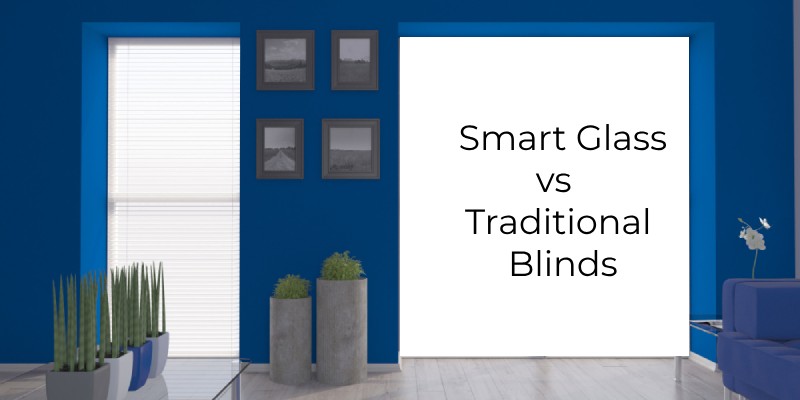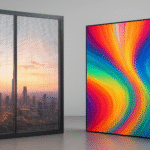Choosing the perfect window treatment is a crucial decision for any space, whether it’s a cosy home or a bustling office. The right choice can influence everything from energy consumption to privacy levels and overall aesthetic appeal. In today’s market, the competition is largely between innovative smart glass and reliable traditional blinds. This article explores the pros and cons of smart glass and traditional blinds, providing a comprehensive guide to help you make an informed choice.
Smart Glass vs Traditional Blinds: Definition
Understanding the fundamental differences between Smart Glass vs Traditional Blinds.
What Is Smart Glass?
Often referred to as switchable glass or smart windows, smart glass represents a significant leap in glazing technology. This cutting-edge material has the capability to change its light transmission properties in response to an electric charge or environmental stimuli.
The primary types of smart glass include:
- Electrochromic: Changes its light transmission properties when voltage is applied. Commonly used in windows and skylights.
- Photochromic: Adjusts its tint based on the intensity of light, ideal for sunglasses and certain windows.
- Thermochromic: Reacts to temperature changes, often used in windows to reduce heat gain.
How It Works:
Smart glass operates by using microscopic particles embedded in the glass layers. These particles rearrange themselves when an electric current is applied, transitioning the glass from opaque to transparent. This technology can be controlled manually via a switch, remote, or even automated through smart home systems and mobile apps. The transition can be gradual, giving users control over the degree of transparency.
What Are Traditional Blinds?
Traditional blinds are a classic and versatile window treatment option. They are typically made from a variety of materials such as wood, fabric, aluminum, or vinyl, and come in several styles, including:
- Venetian Blinds: Feature horizontal slats that can be tilted to control light and privacy.
- Roller Blinds: Consists of a single piece of fabric that rolls up and down, ideal for full light blocking.
- Vertical Blinds: Comprise vertical slats that can be adjusted to control light and are often used for large windows or sliding doors.
How They Function:
Traditional blinds function by using a system of cords, wands, or automated mechanisms to tilt, raise, or lower the slats. This allows users to adjust the amount of light entering a room and control privacy levels. The ease of operation and the wide range of styles make them a popular choice for many spaces.
Smart Glass vs Traditional Blinds: Pros and Cons
Evaluate the Pros and Cons of smart glass vs traditional blinds to determine the best option for your needs.
Pros of Smart Glass
Discover the key benefits that make smart glass a cutting-edge choice for energy efficiency and modern aesthetics.
- Energy Efficiency:
- Significantly lowers heating and cooling costs by dynamically regulating sunlight and heat, promoting a more energy-efficient indoor environment.
- Customizable Transparency:
- Allows for seamless transitions between clear and opaque states, offering versatile privacy control and enhanced light management.
- Aesthetic Appeal:
- Provides a sleek, contemporary appearance that eliminates the need for curtains or blinds, contributing to a minimalist and modern design.
- Noise Reduction:
- Offers superior sound insulation through its multi-layered construction, creating a quieter and more peaceful indoor atmosphere.
- UV Protection:
- Blocks a significant portion of harmful UV rays, protecting interiors from fading and prolonging the life of furnishings and decor.
Cons of Smart Glass
Understand the potential downsides of smart glass, including its high initial cost and technological limitations.
- High Initial Cost:
- Installation is costly due to advanced technology and specialized labour, making it a significant investment upfront.
- Technological Limitations:
- Some versions may exhibit slow transitions between states or limited light control, which can impact overall functionality.
- Maintenance and Repair Challenges:
- Requires professional upkeep and repair, which can be both costly and complex, adding to long-term maintenance expenses.
- Potential Privacy Concerns:
- During power outages or malfunctions, it might revert to a default state, potentially compromising the privacy it provides.
Pros of Traditional Blinds
Explore the advantages of traditional blinds, from their affordability to their ease of installation and diverse style options.
- Cost-Effectiveness:
- Offers a budget-friendly solution for privacy and light control, making them an economical choice for various settings.
- Ease of Installation:
- Installation is straightforward and typically doesn’t require professional help, allowing for quick and easy setup.
- Variety of Styles and Materials:
- Available in numerous styles, colours, and materials, providing extensive customization to match any decor or personal taste.
- User Control and Flexibility:
- Provides precise control over light and privacy with simple adjustments, catering to varying preferences throughout the day.
- Accessibility and Availability:
- Widely accessible and easy to purchase or replace, ensuring that suitable options are always readily available.
Cons of Traditional Blinds
Learn about the drawbacks of traditional blinds, such as their limited energy efficiency and the need for regular maintenance.
- Limited Energy Efficiency:
- Offers basic insulation but lacks the advanced energy-saving capabilities of modern technologies, leading to potentially higher utility bills.
- Maintenance and Cleaning:
- Accumulates dust and dirt, requiring regular cleaning and upkeep to maintain functionality and appearance, which can be time-consuming.
- Potential for Damage and Wear:
- Prone to damage and wear over time, particularly in high-traffic areas or harsh environmental conditions, leading to frequent replacements.
- Aesthetic Limitations:
- May not achieve the sleek, modern look desired in contemporary designs, with cords and slats interrupting the visual flow of a room.
Comparative Analysis: Smart Glass vs. Traditional Blinds
Let’s explore the comparative analysis between Smart Glass and Traditional Blinds:
Energy Efficiency Comparison:
Smart glass provides superior energy efficiency by actively managing solar heat gain and reducing the need for artificial lighting. It helps maintain a consistent indoor temperature, leading to significant energy savings over time. On the other hand, traditional blinds offer basic insulation but are less effective at reducing heat transfer compared to switchable glass. They provide some level of energy efficiency but are not ideal for extreme climates or high-efficiency requirements.
Cost Analysis:
While smart glass involves high initial costs, it offers potential long-term savings through reduced energy bills and lower maintenance costs, making it a worthwhile investment for those looking to save money over time despite the upfront expense. In contrast, traditional blinds are more affordable upfront and easier to replace, making them a budget-friendly option for those who need a quick and cost-effective window covering solution without a significant financial outlay.
Aesthetic and Design Considerations:
Smart glass offers a modern, seamless look that enhances the overall aesthetic of a building. It provides unobstructed views and integrates well with contemporary design themes, adding a sleek and futuristic appeal. Traditional blinds, available in a wide range of styles and materials, allow for customization to match various decor preferences. Although they may not offer the same sleek appearance as switchable glass, they provide versatility in design to suit different tastes and styles.
Installation and Maintenance:
Smart glass requires professional installation and specialized maintenance, which can be more complex and costly. The technology involved necessitates periodic checks and potential repairs. In comparison, traditional blinds are easy to install and maintain, with most issues being simple to fix. Cleaning and occasional adjustments are generally sufficient to keep them in good working condition.
Choosing Between Smart Glass and Traditional Blinds
Choosing between smart glass and traditional blinds depends on:
- Energy Efficiency: This glass saves energy by regulating sunlight; blinds offer basic insulation.
- Aesthetic Appeal: This glass enhances modern interiors; blinds offer diverse styles.
- Cost: This glass is pricier upfront; blinds are more affordable.
- Maintenance: This glass needs specialized care; blinds are easier to maintain.
- Privacy and Light Control: This glass adjusts transparency; blinds offer manual adjustments.
- Durability: This glass lasts longer with proper maintenance.
Conclusion
We’ve explored smart glass vs traditional blinds in depth. Smart glass offers cutting-edge technology and energy efficiency but comes with higher costs and maintenance. Traditional blinds are affordable, versatile, and easy to manage but may lack energy efficiency and modern appeal. Choose based on your needs: sleek tech and savings with switchable glass, or cost-effective flexibility with blinds.
FAQs
Are smart glass windows worth the investment?
Yes, They are worth the investment if you value energy efficiency, modern aesthetics, and dynamic control over light and privacy. The long-term savings in energy costs and the added convenience can justify the initial expense.
Can traditional blinds be automated?
Absolutely, many traditional blinds can be upgraded with motorized systems for remote control, offering a level of convenience similar to switchable glass. This automation allows for easy adjustment of light and privacy settings without manual effort.
How long does smart glass typically last?
With proper care and maintenance, the glass can last for 20 years or more. The longevity of glass depends on factors such as the quality of the installation, usage patterns, and environmental conditions.
What are the best materials for traditional blinds?
The best materials for traditional blinds depend on your needs. For durability, aluminium or PVC are good choices. For a natural and warm appearance, wooden blinds are ideal. Fabric blinds are excellent for a softer look and are easy to clean.
Can switchable glass be installed in existing windows?
Yes, this glass can often be retrofitted into existing windows, although it may require modifications to the window frames and professional installation to ensure proper functionality and performance.





